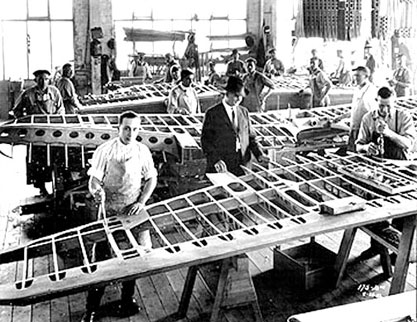Boeing
Seattle, Washington
“Boeing has a long tradition of aerospace leadership and innovation.”
– The Boeing corporate website

In 1996, Fels was invited by Boeing to spend a weekend at the Sleeping Lady Resort in Eastern Washington with the facilities managers of its Seattle-based manufacturing plants. Boeing had contacted the Seattle Arts Commission seeking an artist who would be adept at exploring ‘out of the box’ thinking with the employees. SAC recommended Fels, who then met with those responsible for the Boeing retreat. A few weeks later, Fels traveled to the resort with a supply of empty and flattened cereal boxes, and a trunk full of material gathered at Seattle’s ‘Boeing Surplus’.
After a few remarks about how he viewed the creative process, Fels had the managers gather in small groups around a couple work tables. He distributed the empty cereal boxes to each table and worked through a series of exercises. Fels had the participants open the boxes completely, turning them back to a flat sheet of cardboard. Then with adhesive tape and new folds, he showed how they became ‘reformulated’. The intent was as simple as the material, to explore how an idea (in this case a box) could be refigured- Fels explained this as mind over matter, since the box remained the same piece of cardboard as it began. He had the managers work in teams of two to see what they could do combining their boxes. They quickly discovered that this process was most successful when approaches were discussed before beginning; continuing to share their ideas made for efficient partnering. In a later talk with the managers, Fels stressed the values to be had from truly collaborative endeavors.
After lunch the managers returned to the room to find a large table overflowing with the surplus plane making materials, another with fastening devices. Fels had decided that the process would be most illustrative without any tools, so he had brought a selection of rubber bands, string, quick ties, suction cups etc. He asked the groups to consider what they might want to ‘construct’ with the materials, to go gather what they needed to get started, and then return to their tables and begin work. They could return to the supply and fastening tables as needed.
The results seemed both to surprise and fascinate the attendees. Though working from the same pool of materials, each group produced very different constructions. As Fels wandered the room, he noticed that there were differing levels of communication, teamwork and improvisation taking place. In his talk afterwards, he stressed that the results offered direct evidence of the range of rewards available for varied ways of doing things. The exercise was intended as neither test nor contest, nor was it about judging the final results. But what was evident was that according to the way they brainstormed, and/or delegated tasks, the groups achieved differing levels of complexity.
At the time Fels had been asked to meet with the managers, Boeing was having serious production difficulties, trouble meeting delivery deadlines. Managing the flow of work and materials at the enormous plants was an equally huge job. Fels’ approach helps people visualize the value to creative thinking, they can see a problem being approached and solved in a number of ways. But he pointed out, in order for problem solving to be most effective, it needs to be shared and modified in an on-going fashion with co-workers.